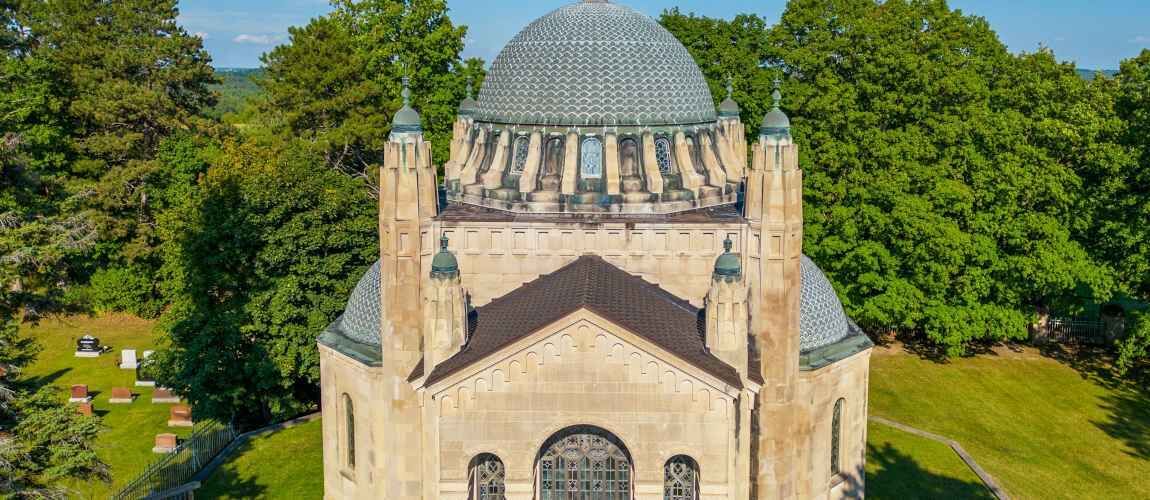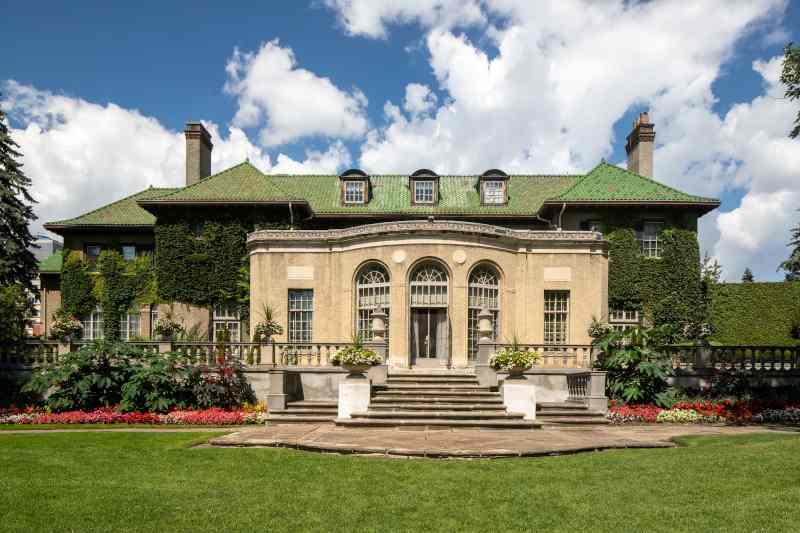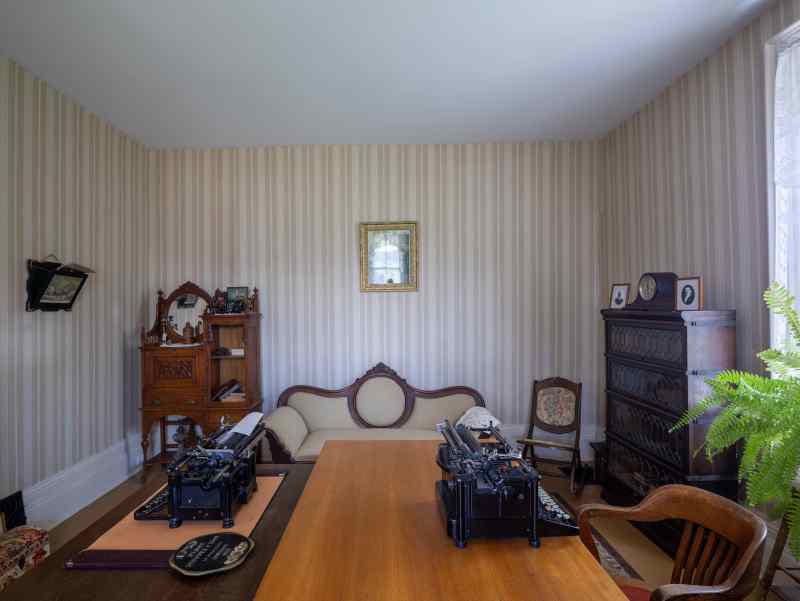Your Eclectic Autumn Road Trip. Marcia Masino
Durham region and the Scarborough Bluffs are described as ‘nature oriented and unassuming.’ Yet where else in Ontario can you hear the whispers of World War II spies and POW camp prisoners, encounter a version of the Taj Mahal while driving down a country road, take photos in a Greek amphitheatre and an architectural graveyard, catch a glimpse of the everyday life of a Canadian literary star and tour the estate of an industrial titan?
Here are seven lesser-known places plus side trip information that make for an extraordinary Autumn excursion.
The Thomas Foster Memorial, where the Ontario countryside meets the Taj Mahal. If you are intrigued by architectural design mysteries, this is for you. Commissioned by the former Toronto Mayor known as Honest Tom Foster, the building was intended to be a majestic crypt for his daughter, wife and himself and they are buried there. This theme was strongly influenced by a visit to the world’s most famous mausoleum, the Taj Mahal.
A passing resemblance to the Taj is presented by the exterior, but there are other influences: a harmonious blend of Byzantine Christian iconography, Egyptian, Indian and Masonic symbolism are to be found within. The intertwining of diverse creeds is unique and quite an accomplishment. The space dazzles with rich jewel-like colours and real gold c complimented by heavenly sky blue. Majestic mosaic floors and walls of intricate terrazzo and marble mosaics, marble pillars and stained-glass windows complete the design. During summer evening concerts, as the western sunset lights up the interior, these features are especially highlighted. Along with concerts, meditation sessions are hosted.
In the language of architecture, the image on the entrance way floor often represents the theme or deity to which the building is dedicated. Crossing this threshold is a mosaic pavement of white floating lotus flowers on a dark marble background representing the river Styx aka the River of Death (remember, this is a mausoleum.) Opening at sunrise and closing at sunset, the white lotus flower is especially revered in Egypt and India. It is regarded as symbolic of the emergence of light from darkness or of death and rebirth, appropriate for Foster’s intention. Look up to the lower quadrant above the great arches of the dome to read the gold lettering on a background of blue mosaic, “Take this my body for it is done and I have gained a new life, glorious and eternal.” More symbolic mysteries await discovery in this unusual building. Here’s a clue – just follow the sun.
The Lucy Maud Montgomery Manse is the home of the eponymous author who was already a celebrated Canadian writer (Anne of Green Gables) by the time she moved to Leaskdale, north of Uxbridge with her Presbyterian minister husband. Living there for fifteen years from 1911, she wrote eleven novels in that period , became a mother and regarded the Leaskdale Manse as the first home she could call her own.
She writes in her journal:
“[the manse] is quite prettily situated. It is not an ideal house by any means, but it will do, and it is certainly much more comfortable and convenient than my old home. It is built of white brick in the ugly ‘L’ design so common among country houses. My greatest disappointment in connection with it is that it has no bathroom or toilet. I had hoped that I might have a home with these at least. But what is to be will be! It is Allah! We must submit!” *
This is a wonderful opportunity to visit the home of a Canadian literary icon and feel her vibe. The house is lovingly restored by the current caretakers and her true life with all its responsibilities and joys is represented by the dedicated staff who endeavour to replicate Maud’s taste. Tours are available at the house and the church across the street where her husband preached.
Parkwood Estate is Oshawa’s top attraction. The 55 room mansion and grounds have been the backdrop for numerous film and television productions over the years. The Camp X memorial at Intrepid Park in Whitby commemorates the men and women who trained at the British spy school located there during World War II.
Parkwood Estate is the Oshawa home of the auto baron and philanthropist, R.S. McLaughlin. He founded the McLaughlin Motor Car Company in 1907, one of the first major automobile manufacturers in Canada. It evolved into General Motors of Canada.
Built between 1915 and 1917 in the Beaux-arts style, unlike many other historic residences, Parkwood’s décor, furnishings, art, architecture, landscaping and gardens are original. Visiting the estate, there is a feeling in the rooms that the family still lives there. The dining room table is set with their china and glassware; mementos and favourite items are displayed throughout the home creating an ambience that only the authentic items can give.
Parkwood’s eleven acres of variously styled landscapes and gardens, such as, Italian, sunken, sundial, formal, also have sculptures and architectural embellishments that create great photographic opportunities. Designated a National Heritage Site with house and specialty tours such as Servant’s life experience and the Art Collection, plus popular workshops, the estate is alive with activity, just the way the McLaughlin’s would have wanted.
Mr. McLaughlin’s home was used as a meeting place for officers involved with the covert espionage training facility, Camp X during World War II. Camp X was a secret spy training camp located in Oshawa, made famous by the CBC television series, ‘X Company.’ It was the first school of its kind in North America and it also served as a top-secret communication station. The facility also had a cold war legacy. Legend has it that Ian Fleming, the author of the James Bond books trained there along with over five hundred Canadian and American civilians who became intelligence specialists.
You can look for it but you will not find it because of course it was destroyed. However, the site of Camp X is now called Intrepid Park. It has two historic plaques, one dedicated to Camp X and the other to its founder, ‘Intrepid’ Stephenson. Bring your metal detector because artifacts are often found at the site.
“They wanted them as far away as possible so they sent them here,” is what was said of Camp 30 WW II POW Camp Bowmanville. Picture a group of old abandoned graffitied buildings in a large field in Bowmanville. Believe it or not this site was a prisoner of war camp. Originally a boy’s school built in the 1920s, it was repurposed by the government in 1941. It held some of the highest-ranking German officers captured by the Allies. Camp 30 is the only known prisoner of war camp left in Canada.
Although largely in disarray, some of the rooms and structures remain ‘eerily’ in place, frozen in time. Grungy, ghostly and scheduled for an overhaul ‘someday’, it remains worth a visit. There are sidewalks and security cameras; better hurry if you want to experience this rare abandoned site in its authentic state.
The Ehrenwort Trail is a unique path linking residential Bowmanville to the site of the camp. The trail’s name, Ehrenwort, means ‘word of honour’ and it was actually used by the prisoners who were given come and go privileges as long as they kept their word to return. Free guided walks are offered by members of the Architectural Conservancy of Ontario’s Clarington Branch.
Located at The Guild Inn, the Guild Park and gardens have a historic architectural grave yard with relics from downtown Toronto buildings along with a Greek amphitheatre style stage. You can roam around the sculpture garden with its rescued ruins and facades that make for great artistic photographic compositions. Architectural remnants represent the Victorian, Beaux-arts Gothic Revival styles taken from the old Toronto Star building, the Granite club and various banks. There are over sixty pieces plus sculptures by Sorel Etrog all on the ninety acre Guild Inn estate.
Guild park is situated on the Scarborough Bluffs with views of Lake Ontario. Make sure you leave enough time to explore this escarpment’s incredible views. The region has eleven parks with trails, gardens and beaches to enjoy.
Take an eclectic autumn road trip, discover mysterious symbolic architecture, unique Canadian culture, natural settings, military history and unusual artistic and photographic opportunities. All you need is transportation, curiosity, a camera and your favourite road map technology.
*From the Selected Journals of L.M. Montgomery, Vol. II page 82.






